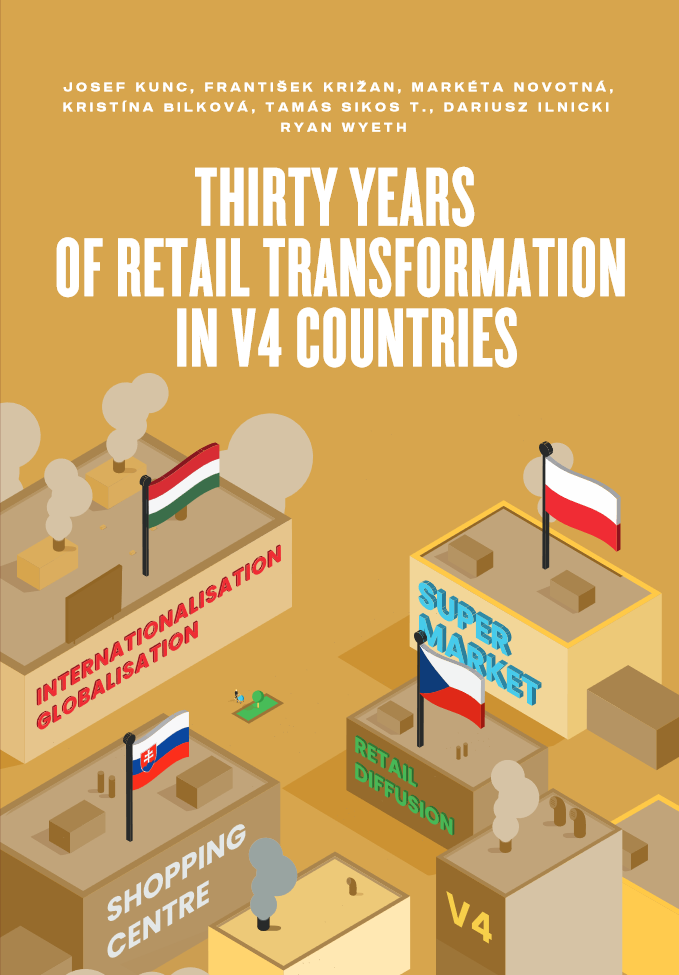
Dr hab. D. Ilnicki as a co-author of an international publication
As a result of the cooperation of researchers from the Czech Republic (Josef Kunc, Markéta Novotná), Slovakia (František Križan, Kristina Bilková), Poland (dr hab. Dariusz Ilnicki, Ryan Wyeth) and Hungary (Tamás Sikos T.), the publishing house De Gruyter Poland Sp. z o. o.o. published a monograph in English Thirty years of retail transformation in V4 countries, which deals with the transformation of retail trade in the last thirty years (1990-2020) in the countries forming the Visegrad Group (V4). It is worth noting that the main considerations, regarding the transformation of the retail trade after 1990, are set in a broader context, namely its functioning in the realities of a centrally controlled economy.
The monograph consists of seven chapters. The introductory chapter summarises 30 years of post-socialist retail transformation in Central Europe, highlighting its main features and manifestations. Each of the next four main chapters, is dedicated to one of the V4 countries (Czech Republic, Slovakia, Hungary and Poland). The structure of the aforementioned chapters, when viewed as a whole on the issue of retail transformation, has its own peculiarities. It is primarily, or perhaps even primarily, due to the availability of data, including data from official statistics. Secondly, it is important to point out the scientific specialisation of the authors of the individual chapters (economics, geography, management). Chapter six compares and discusses the key similarities, differences and specificities of retail transformation in the V4 countries. The final chapter focuses on current socio-economic challenges, current trends and basic technological innovations currently used in retailing. In addition, attention was given to the transformation of retail in the context of the COVID-19 pandemic.
Until 1990, the way in which the national economy was managed strictly defined, determined the spatial and consumer nature of retailing, in other words, the places of sale, their structures, products, etc. The turn of the 1980s and 1990s was a time of transition from a centralised economy to one governed by market mechanisms. In retail, this has been manifested, among other things, by the emergence of new retail formats (superstores, hypermarkets, discount stores), the growth in their number, or the evolution of the structure of the characteristics that describe them. A particular form of retail is shopping centres, which are a key trigger for changing consumer behaviour. These facilities have become an attraction, an entertainment, a form of leisure and even a specific form of social gathering, especially for young people. Gradually, they also began to act as relatively safe public spaces, spaces and meeting places. In general, understanding consumer behaviour, their patterns, is a fundamental issue in contemporary retail approaches. This applies not only to the location, organisation and operation of retail establishments, at all levels, but also to the size and type of services offered.
The text of the study provides a comprehensive look at the development and transformation of retail in the Czech Republic, Slovakia, Poland and Hungary. The monograph reveals current trends in the use of smart technology in commerce. It offers a quantitative, qualitative and structural presentation of the phenomena and processes characteristic of contemporary retailing, highlighting both the economic and spatial aspects. In addition, it includes, records the impact of the COVID-19 pandemic on modern retailing (e.g. changes in consumer behaviour, increase in online shopping, changing supplier-buyer relationships, etc.), which is currently an important area of research for the service sector, including retail.




